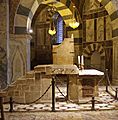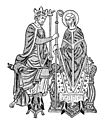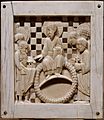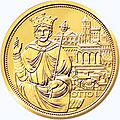Otto I the Great facts for kids
Quick facts for kids Otto the Great |
|
|---|---|

Depiction of Otto I on his seal in 968
|
|
| Holy Roman Emperor | |
| Reign | 2 February 962 – 7 May 973 |
| Coronation | 2 February 962 Old St. Peter's Basilica, Rome |
| Predecessor | Berengar of Friuli |
| Successor | Otto II |
| King of Italy | |
| Reign | 25 December 961 – 7 May 973 |
| Coronation | 10 October 951 Pavia |
| Predecessor | Berengar II |
| Successor | Otto II |
| King of Germany (East Francia) | |
| Reign | 2 July 936 – 7 May 973 |
| Coronation | 7 August 936 Aachen Cathedral |
| Predecessor | Henry the Fowler |
| Successor | Otto II |
| Duke of Saxony | |
| Reign | 2 July 936 – 7 May 973 |
| Predecessor | Henry the Fowler |
| Successor | Bernard I |
| Born | 23 November 912 possibly Wallhausen, East Francia |
| Died | 7 May 973 (aged 60) Memleben, Holy Roman Empire |
| Burial | Magdeburg Cathedral |
| Spouse | Eadgyth of England (930–946) Adelaide of Italy (951–973) |
| Issue | William, Archbishop of Mainz Liutgarde of Saxony Liudolf, Duke of Swabia Matilda, Abbess of Quedlinburg Otto II, Holy Roman Emperor |
| Dynasty | Ottonian |
| Father | Henry the Fowler |
| Mother | Matilda |
| Religion | Roman Catholic |
| Signum manus | 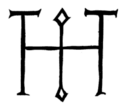 |
Otto I the Great was a very important ruler in medieval Europe. He was born on November 23, 912, and passed away on May 7, 973. His father was Henry I the Fowler, who was the King of the Germans. His mother was Matilda of Ringelheim. Otto became the Duke of the Saxons, then the King of the Germans, and later the Holy Roman Emperor. He helped shape the future of Germany and Europe.
Contents
Becoming King of Germany
Otto became the King of Germany in 936, after his father died. He was crowned in Aachen Cathedral, a very old and important church. This church was built by Charlemagne, another famous emperor. Otto wanted to be a strong ruler, just like Charlemagne.
Dealing with Rebellions
When Otto became king, some powerful dukes in Germany were not happy. They wanted more power for themselves.
- In 937, some dukes rebelled against Otto.
- Again in 939, more dukes tried to overthrow him.
Otto was a strong leader and managed to defeat these rebellions. He showed everyone that he was in charge.
Strengthening His Power
To make his rule stronger, Otto gave important jobs to bishops and abbots. These were church leaders.
- He trusted them more than the dukes.
- He gave them land and power.
- This helped him control the different parts of Germany better.
This system was called the "Ottonian Church System." It made the church leaders very important in the government.
Conquering Italy
Otto also became involved in the politics of Italy.
- In 951, he went to Italy for the first time.
- He took control of the Iron Crown of Lombardy, which was a symbol of power in Italy.
- He married Adelaide of Italy, who was an Italian queen. This marriage helped him gain more influence in Italy.
Battle of Lechfeld
In 954 and 955, a group called the Hungarians invaded Germany. They were fierce warriors from the east.
- Otto gathered his army to fight them.
- The big battle happened at Battle of Lechfeld in 955.
- Otto's army won a great victory. This stopped the Hungarian invasions for good.
This victory made Otto a hero in Germany and all of Europe.
Becoming Holy Roman Emperor
Because of his power and influence, Otto was invited to Rome.
- On February 2, 962, he was crowned Holy Roman Emperor by Pope John XII.
- This was a very important moment. It brought back the idea of a large, unified Christian empire in Europe.
- The Holy Roman Empire would last for many centuries.
Otto's coronation showed that he was the most powerful ruler in Europe.
Later Years and Legacy
Otto ruled as Emperor for over a decade. He continued to strengthen his empire.
- He made sure his son, Otto II, would become the next emperor.
- He died in 973 and was buried in Magdeburg Cathedral.
Otto the Great is remembered for uniting Germany, stopping invasions, and creating the Holy Roman Empire. He laid the foundation for a powerful German state that would last for a long time.
Images for kids
-
12th-century stained glass depiction of Otto I, Strasbourg Cathedral
-
Side view of the Throne of Charlemagne at Aachen Cathedral, where Otto was crowned King of Germany in 936
-
Central Europe, 919–1125. The Kingdom of Germany included the duchies of Saxony (yellow), Franconia (blue), Bavaria (green), Swabia (orange) and Lorraine (pink left). Various dukes rebelled against Otto's rule in 937 and again in 939.
-
A medieval king investing a bishop with the symbols of office. Otto centralized his control over Germany through the investiture of bishops and abbots.
-
A 1457 illustration of the Battle of Lechfeld in Sigmund Meisterlin's codex about the history of Nuremberg
-
The Imperial Crown of the Holy Roman Empire. Otto was crowned as Emperor on February 2, 962 by Pope John XII.
-
Contemporary image of Otto I, lower left, in one of the Magdeburg Ivories. Otto presents Magdeburg Cathedral to Christ and Saints, and is depicted smaller than them as a sign of humility.
See also
 In Spanish: Otón I del Sacro Imperio Romano Germánico para niños
In Spanish: Otón I del Sacro Imperio Romano Germánico para niños



